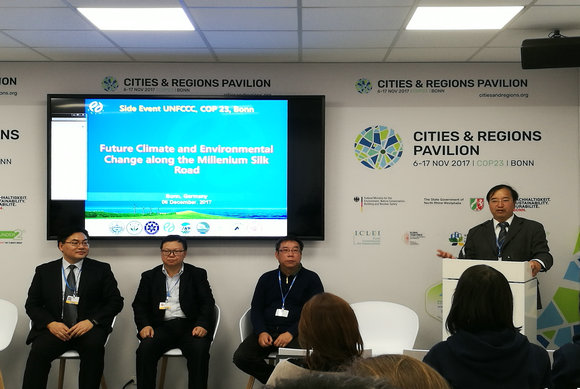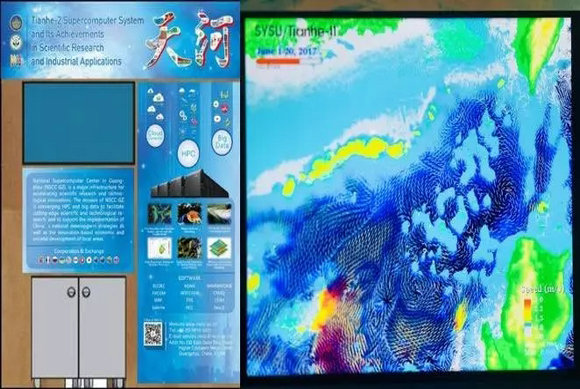United Nations Climate Change Conference—Let the world hear the voice from Sun Yat-sen University
Source: School of Atmospheric Sciences
Written by: School of Atmospheric Sciences
Edited by: Wang Dongmei
A new round of the United Nations Climate Change Conference (COP23) opened in Bonn, Germany on 6 November 2017, which would last until 17 November 2017. Further discussion on the rules for the implementation of the Paris Agreement will be conducted in this conference. More than 25,000 delegates from 195 parties to the Paris Agreement attend the conference. The Chinese government sent a delegation composed of delegates from related departments and experts to attend the conference. The German media appreciated the adoption of measures and policy for the mitigation and adaption to climate change by China in recent years and the Chinese solutions-actions promoting the global climate governance by China.

Professor Wenjie Dong elaborating on the future climate change along the Millennium Silk Road
On the conference opening day, a side event “The future climate and environment change along the Millennium Silk Road”, jointly organized by China Association for Science and Technology, Chinese National Committee for Future Earth, Chinese Academy of Sciences and China Meteorological Administration, was held at the Cities and Regions Pavilion in the Bonn zone. Professor Wenjie Dong, Dean of the School of Atmospheric Sciences at Sun Yat-sen University, was invited to serve as the head of delegation of COP23 by the Working Group for UN Environment Consultation - China Association for Science and Technology (WGUNEC-CAST), and chaired the side event.
In the meeting, Prof. Dong firstly introduced the history of the “Millennium Silk Road”, which acted as the road of trade, the road of peace, the road of development, the road of friendship, and the road of prosperity. Prof. Dong then elaborated on the Belt and Road Initiative, as well as the significance of studying global climate change for regional climate, ecosystem, environment and sustainable development. Furthermore, Prof. Dong briefly introduced the related work progress of Chinese National Committee for Future Earth and the efforts using supercomputer to predict the future climate and environment change along the “Millennium Silk Road” in China.

Exhibition of “Tianhe-2” supercomputer system, displaying the newest applications of the supercomputer
Dr. Chenchen Wang from China Association for Science and Technology and Dr. Lei Lin from Sun Yat-sen University presented the application of “Tianhe-2” supercomputer system (housed in the National Supercomputer Center in Guangzhou located at Sun Yat-sen University) in the development of Atmospheric and Oceanic model, weather forecast, climate prediction and evaluation of climate change. Through video and images, the simulation and prediction of high-resolution global and regional motion of atmosphere and ocean were displayed.
The two-week exhibition displays the latest progress in the development and application of supercomputer in China, especially China’s important role in the study of climate change, attracting many delegates and media to visit and discuss, and bringing international attention.
It is learned that since its establishment in 2005, the School of Atmospheric Sciences at Sun Yat-sen University has chaired two projects related to “climate change and its adaption” funded by the National Key Research and Development Program of China. The platform of “climate change and its adaption” has been built. With the support of “Tianhe-2”, Sun Yat-sen University has achieved a rapid progress in the R&D and application of weather and climate system model, yielding impressive results in serving national strategies, cultivating talents for mitigating climate change and related research.
